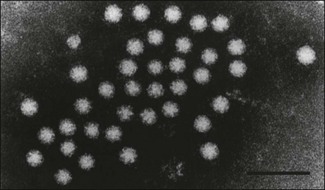Chapter 54 The name of the family is derived from the Greek word astron meaning star and referring to the star-like surface structure of member virions. Astroviruses are non-enveloped with icosahedral symmetry, 28–30 nm in diameter (Fig. 54.1). The genome consists of a single molecule of linear, positive-sense, single-stranded RNA. The viruses are resistant to pH 3, various detergents and heat (60°C for 5 minutes). Replication is cytolytic and occurs in the cytoplasm of host cells. The presence of trypsin is required for cultivation of these viruses in cell culture. There are two genera, Mamastrovirus and Avastrovirus representing mammalian and avian astroviruses (Fig. 54.2) with type species Human astrovirus and Turkey astrovirus respectively. Species within these genera are defined on the basis of the animal species they infect. Isolates from different host species are antigenically unrelated and are species-specific. Eight serotypes of human astrovirus have been described, two serotypes of bovine astrovirus and three of turkey astrovirus. Figure 54.1 Negative contrast electron micrograph of virions of human astrovirus from a stool specimen. The bar represents 100 nm. Reprinted with permission: Fauquet CM (ed) et al. 2005 Virus Taxonomy Eighth Report of the International Committee on Taxonomy of Viruses, Elsevier Academic Press, p. 859.
Astroviridae

Astroviridae
Only gold members can continue reading. Log In or Register to continue

Full access? Get Clinical Tree


